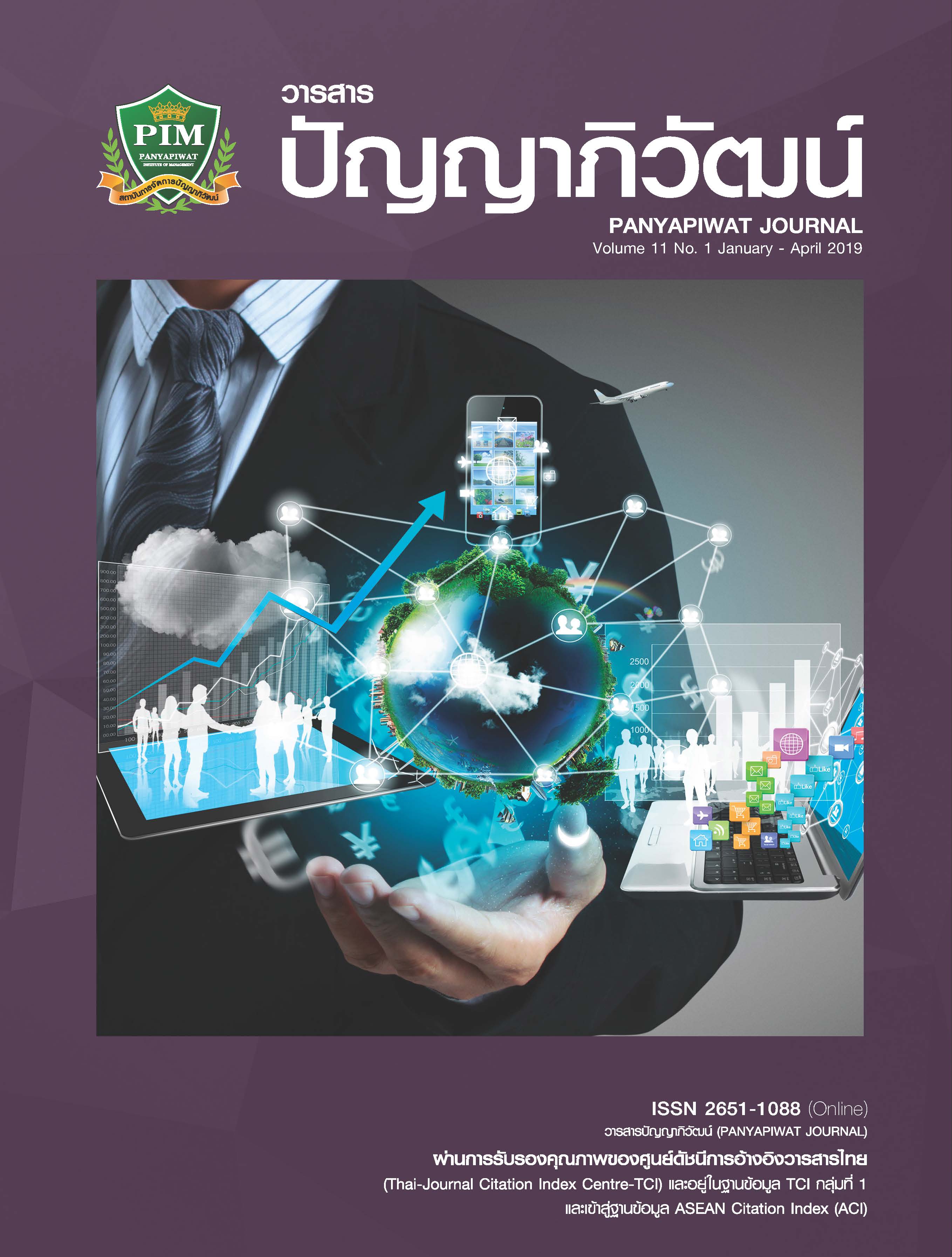โมเดลปัจจัยเชิงสาเหตุที่มีอิทธิพลต่อความสำเร็จของธุรกิจโรงแรมในประเทศไทย
Main Article Content
บทคัดย่อ
การวิจัยนี้มีวัตถุประสงค์เพื่อวิเคราะห์ความสัมพันธ์ของปัจจัยเชิงสาเหตุ ซึ่งประกอบด้วย 1) ศึกษาอิทธิพลของภาวะผู้นำด้านการเปลี่ยนแปลง วัฒนธรรมการเรียนรู้ และความสามารถทางการแข่งขันต่อความสำเร็จของบริษัท 2) ศึกษาอิทธิพลของภาวะผู้นำด้านการเปลี่ยนแปลง และวัฒนธรรมการเรียนรู้ต่อความสามารถทางการแข่งขัน
3) ตรวจสอบความสอดคล้องกลมกลืนของโมเดลปัจจัยเชิงสาเหตุที่มีอิทธิพลต่อความสำเร็จของธุรกิจโรงแรมในประเทศไทย กลุ่มตัวอย่างที่ใช้ในการวิจัยครั้งนี้คือ องค์กรธุรกิจโรงแรมในประเทศไทย จำนวน 311 โรงแรม โดยใช้แบบสอบถามเป็นเครื่องมือซึ่งมีค่าน้ำหนักองค์ประกอบ (Factor Loadings) อยู่ระหว่าง .861-.938 และมีค่าสัมประสิทธิ์
แอลฟาครอนบาค (Cronbach’s alpha coefficient) อยู่ระหว่าง .869-.936 วิเคราะห์ข้อมูลโดยใช้โมเดลสมการโครงสร้าง (SEM)
ผลการวิจัยพบว่า 1) ความสามารถทางการแข่งขันมีอิทธิพลทางตรงต่อความสำเร็จของบริษัท ในขณะที่ผู้นำด้านการเปลี่ยนแปลง และวัฒนธรรมการเรียนรู้ไม่มีอิทธิพลทางตรงแต่มีอิทธิพลทางอ้อมต่อความสำเร็จของบริษัทผ่านความสามารถทางการแข่งขัน 2) ผู้นำด้านการเปลี่ยนแปลง และวัฒนธรรมการเรียนรู้มีอิทธิพลทางตรงต่อความ
สามารถทางการแข่งขัน สำหรับรูปแบบความสัมพันธ์เชิงสาเหตุ ผลการวิเคราะห์ข้อมูลพบว่า โมเดลการวิเคราะห์มีความสอดคล้องกับข้อมูลเชิงประจักษ์พบว่า โมเดลมีความเหมาะสมพอดีกับข้อมูลเชิงประจักษ์อยู่ในเกณฑ์ดี (χ2/df = 1.46, p = .053, CFI = .995, TLI = .993, RMSEA = .033, SRMR = .014)
Article Details
“ข้าพเจ้าและผู้เขียนร่วม (ถ้ามี) ขอรับรองว่า บทความที่เสนอมานี้ยังไม่เคยได้รับการตีพิมพ์และไม่ได้อยู่ระหว่างกระบวนการพิจารณาลงตีพิมพ์ในวารสารหรือแหล่งเผยแพร่อื่นใด ข้าพเจ้าและผู้เขียนร่วมยอมรับหลักเกณฑ์การพิจารณาต้นฉบับ ทั้งยินยอมให้กองบรรณาธิการมีสิทธิ์พิจารณาและตรวจแก้ต้นฉบับได้ตามที่เห็นสมควร พร้อมนี้ขอมอบลิขสิทธิ์บทความที่ได้รับการตีพิมพ์ให้แก่สถาบันการจัดการปัญญาภิวัฒน์หากมีการฟ้องร้องเรื่องการละเมิดลิขสิทธิ์เกี่ยวกับภาพ กราฟ ข้อความส่วนใดส่วนหนึ่งและ/หรือข้อคิดเห็นที่ปรากฏในบทความข้าพเจ้าและผู้เขียนร่วมยินยอมรับผิดชอบแต่เพียงฝ่ายเดียว”
เอกสารอ้างอิง
Agoda. (2016). Agoda.com–Agoda Thailand. Retrieved March 15, 2016, from https://www.agoda.com/th-th/country/thailand.html [in Thai]
Bangkokbiznews. (2016). Special Articles: Hotel business intense competition 2016. Retrieved March 15, 2016, from https://www.bangkokbiznews.com/blog/detail/640668 [in Thai]
Bass, B. M. & Avolio, B. J. (1995). Multifactor leadership questionnaire: manual for research. Redwood City, CA: Mind Garden.
Bollen, K. A. (1986). Sample size and bentler and Bonett’s normed ft index. Psychometrika, 51(3), 375-377.
Bontis, N. (1999). Managing an organizational learning system by aligning stocks and flows of knowledge: an empirical examination of intellectual capital, knowledge management, and business performance. Hamilton: Management of innovation and new technology research centre.
Bunnoon, P. & Ussahawanitchakit, P. (2012). Proft planning effciency, goal achievement, and frm success: evidence from canned foods business in Thailand. Journal of International Business and Economics, 12(4), 1-16.
Dustin, G., Bharat, M. & Jitendra, M. (2014). Competitive advantage and motivating innovation. Advances in Management, 7(1), 1-7.
García-Morales, V. J., Jiménez-Barrionuevo, M. M. & Gutiérrez-Gutiérrez, L. (2012). Transformational leadership influence on organizational performance through organizational learning and innovation. Journal of Business Research, 65(7), 1040-1050.
Hair, J. F., Black, W. C., Babin, B. J. & Anderson, R. E. (2010). Multivariate data analysis (7th ed.). New Jersey: Pearson Education.
Hair, J. F., Anderson, R. E., Tatham, R. L. & Black, W. C. (2006). Multivariate Data Analysis (5th ed.). Upper Sadie River, NJ: Pearson Education Incorporation.
Kamya, M. T., Ntayi, J. M. & Ahiauzu, A. (2011). Organisational learning and competitive advantage: testing for the interacting influence of knowledge management and innovation. International Journal of Innovation and Learning, 10(4), 376-401.
Kline, R. B. (2012). Assumptions in structural equation modeling. In R. H. Hoyle (Ed.). Handbook of structural equation modeling. New York: Guilford Press.
Michael, J. (2000). Implications and refnements of the establishing operation concept. Journal of Applied Behavior Analysis, 33(1), 401-410.
Nonaka, I. & Takeuchi, H. (1995). The knowledge-creating company: how Japanese companies create the dynamics of innovation. New York: Oxford University Press.
Nonaka, I. & Toyama, R. (2003). The knowledge-creating theory revisited: knowledge creation as a synthesizing process. Knowledge Management Research & Practice, 1(1), 2-1.
Nunnally, J. & Bernstein, I. (1994). Psychometric theory (3rd ed.). New York: McGraw-Hill.
Parrish, E., Berdine, M., Cassill, N. & Oxenham, W. (2008). Measuring the competitive advantage of the US textile and apparel industry. Paper presented at 2008 Industry Studies Annual Conference, Boston, MA.
Pongpearchan, P. (2016). Effect of transformational leadership on strategic human resource management and frm success of Toyota’s dealer in Thailand. Journal of Business & Retail Management Research, 10(2), 53-63.
Pontin, P. & Chunnual, N. (2016). Factors affecting the success of management of mahachulalongkornrajavidyalaya campuses. Valaya Alongkorn Review, 11(3), 169-182. [in Thai]
Schmitt, A. & Klarner, P. (2015). From snapshot to continuity: a dynamic model of organizational adaptation to environmental changes. Scandinavian Journal of Management, 31(1), 3-13.
Schumacker, R. E. & Lomax, R. G. (2010). A beginners guide to structural equation modeling (3rd ed.). New York: Routledge.
Shih, K. H., Chang, C. J. & Lin, B. H. (2010). Assessing knowledge creation and intellectual capital in banking industry. Journal of Intellectual Capital, 11(1), 74-89.
Spanos, Y. E. & Lioukas, S. (2001). An examination into the causal logic of rent generation: Contrasting Porter’s competitive strategy framework and the resource-based perspective. Strategic Management Journal, 22(10), 907-934.
Teece, D. J., Pisano, G. & Shuen, A. M. Y. (1997). Dynamic capabilities and strategic management. Strategic Management Journal, 18(7), 509-533.
Winter, S. G. (2003). Understanding dynamic capabilities. Strategic Management Journal, 24(10), 991-995.


